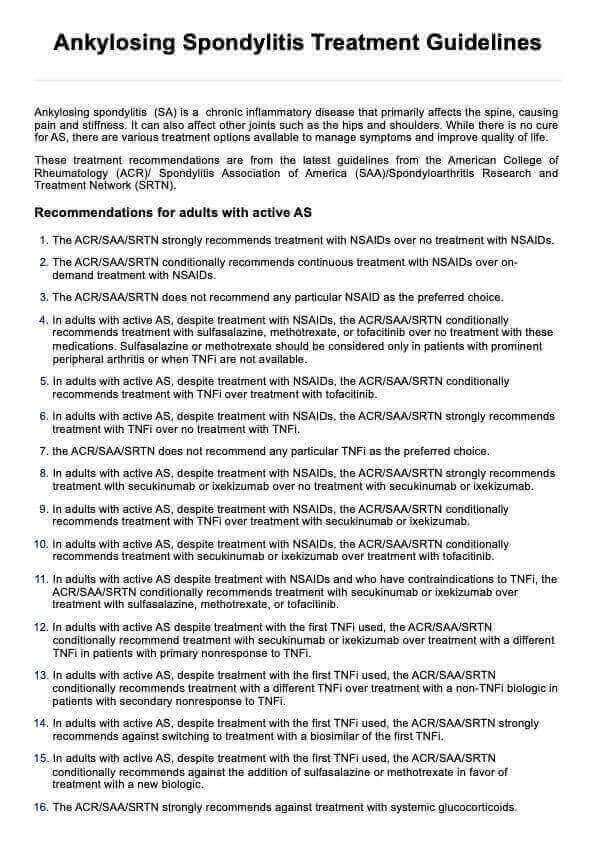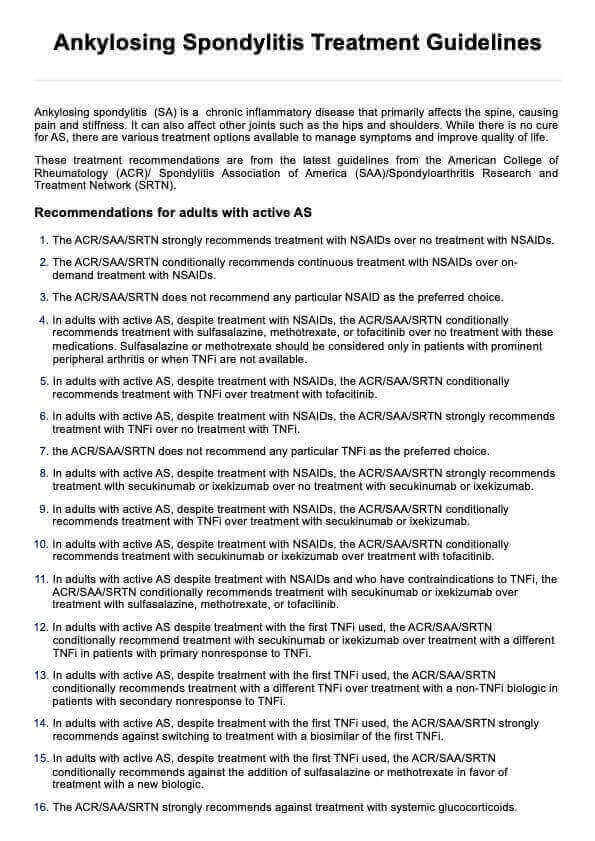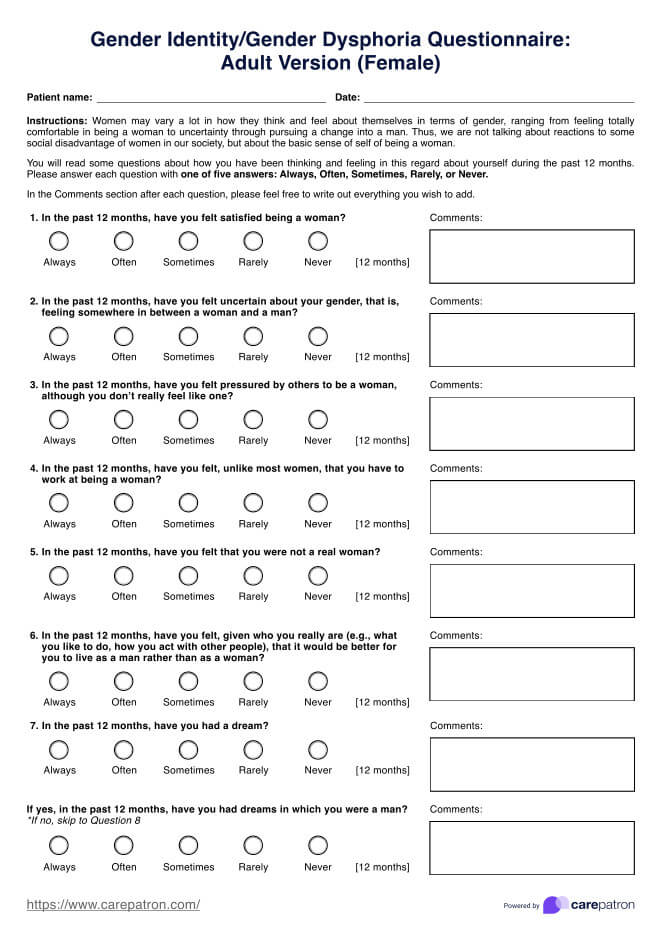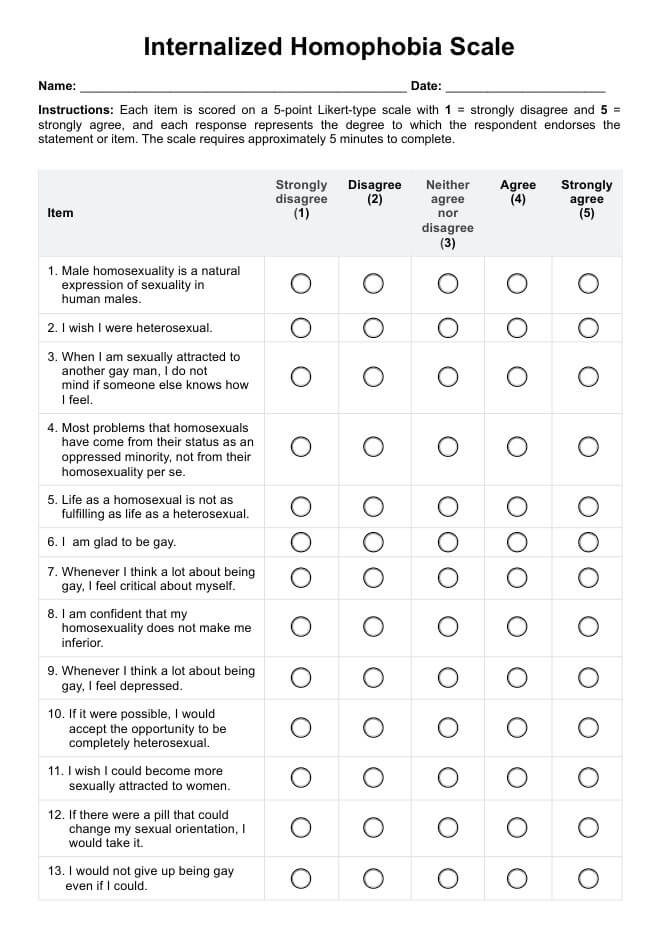Ankylosing Spondylitis Treatment Guidelines Handout
Learn how to effectively diagnose, treat, and manage ankylosing spondylitis with our comprehensive treatment guidelines handout for healthcare professionals.


What is ankylosing spondylitis?
Ankylosing spondylitis (AS) is a type of arthritis primarily affecting the spine, although other joints and areas around the body can also be involved, including complications like inflammatory bowel disease. It's characterized by inflammation that can lead to the fusion of vertebrae, resulting in reduced flexibility and potentially a hunched-forward posture. The disease is more common in men than women and typically begins in early adulthood.
Risk factors
- Genetic predisposition: Most people with AS have the HLA-B27 gene, although having the gene does not guarantee that one will develop ankylosing spondylitis.
- Family history: Having a family member with AS increases the risk.
- Age: Symptoms usually start in late adolescence or early adulthood.
- Sex: Men are more commonly affected than women.
Symptoms
- Chronic back pain and stiffness: Pain is often worse after periods of inactivity or during the night and improves with exercise.
- Fatigue: Due to inflammation.
- Pain and swelling in other parts of the body: Such as the shoulders, hips, ribs, heels, and small joints of the hands and feet.
- Reduced range of motion: Advanced cases can lead to a decreased ability to perform daily activities and may progress to radiographic axial spondyloarthritis.
Diagnosis
How to diagnose ankylosing spondylitis is typically based on:
- Symptoms: Chronic back pain and stiffness.
- Physical examination: Checking for signs of inflammation and restricted movement.
- Imaging tests: X-rays or magnetic resonance imaging (MRI) scans to detect joint and bone changes.
- Blood tests: Mainly to check for the presence of the HLA-B27 gene and inflammation markers.
Ankylosing Spondylitis Treatment Guidelines Handout Template
Ankylosing Spondylitis Treatment Guidelines Handout Example
How to manage and treat Ankylosing Spondylitis?
How is ankylosing spondylitis treated? It involves a combination of medication, exercise, and lifestyle adjustments to reduce symptoms, maintain mobility, and prevent complications. Here's a look at the primary strategies:
Medications
Medications are a cornerstone of treatment for AS, aimed at reducing inflammation, relieving pain, and slowing disease progression. These include:
- Nonsteroidal anti-inflammatory drugs (NSAIDs): These are typically the first line of treatment to help reduce inflammation and alleviate pain.
- Tumor necrosis factor inhibitor: These are biological drugs that can significantly reduce inflammation and prevent the progression of joint damage.
- Interleukin-17 (IL-17) inhibitors: Another class of biologic that blocks a different inflammatory pathway and is beneficial in cases where TNF inhibitors are unsuitable or ineffective.
- Disease-modifying antirheumatic drugs (DMARDs): Sometimes used, although less commonly than in other forms of arthritis, to target the underlying immune processes.
Physical therapy and exercise
Regular exercise and physical therapy are critical in managing AS. Stretching and strengthening exercises help maintain joint flexibility and muscle strength, reducing the risk of stiffness. Posture training is essential to prevent or manage the spinal curvature that can occur as the disease progresses. Additionally, engaging in aerobic exercises such as walking, swimming, or cycling can improve overall cardiovascular health without putting too much strain on the joints.
Lifestyle modifications
Lifestyle changes can help manage symptoms and improve quality of life. Adopting good sleeping positions and using proper bedding can help maintain spine alignment and reduce joint pain. Quitting smoking is also crucial, as smoking can exacerbate symptoms and potentially accelerate the progression of AS. Maintaining a healthy weight is important to reduce stress on the joints and promote overall health.
Regular monitoring and check-ups
Regular visits to a healthcare provider are important to monitor disease progression and adjust treatments as necessary to manage symptoms and complications. It is also essential to screen for related conditions, such as rheumatoid arthritis, uveitis (eye inflammation), or cardiovascular issues, which are more common in individuals with AS.
Surgery
In severe cases, surgery might be necessary. Joint replacement may be required for severely damaged hips or other joints. Spinal surgery could be needed to correct severe deformities or stabilize the spine, ensuring a better quality of life for those affected by AS.
What is an Ankylosing Spondylitis Treatment Guidelines Handout?
An ankylosing spondylitis treatment guidelines handout is a comprehensive document designed to help healthcare professionals manage AS. The information laid out in the template are guidelines from the American College of Rheumatology (ACR)/ Spondylitis Association of America (SAA)/Spondyloarthritis Research and Treatment Network (SRTN).
This handout is primarily used by rheumatologists responsible for diagnosing and tailoring treatment plans. General practitioners can use it for initial management and referrals. Based on the guidelines, physiotherapists can implement and monitor treatment protocols. Nurses and nurse practitioners can provide patient education, disease monitoring, and support, while pharmacists can assist with medication management and patient counseling.
Benefits of using this handout
Using an Ankylosing Spondylitis Treatment Guidelines Handout offers numerous benefits for healthcare providers and patients. It is a quick reference tool for practitioners, ensuring consistency and adherence to the latest treatment protocols.
This promotes standardization in care across different providers, reducing variability in treatment approaches and enhancing overall patient outcomes. Additionally, having a structured guideline helps educate new staff or less experienced clinicians, boosting their confidence and competence in managing this complex condition.
Commonly asked questions
The exact cause of AS is unknown, but it involves a combination of genetic and environmental factors. The presence of the HLA-B27 gene is closely associated with AS, although not everyone with the gene will develop the condition.
There is currently no cure for AS, but effective treatments are available that can manage symptoms, reduce the risk of complications, and maintain normal function and quality of life.
Yes, regular exercise is crucial in managing AS. It helps maintain joint flexibility and muscle strength, reduces stiffness, and improves overall well-being. Tailored exercise programs under the guidance of a physical therapist can be particularly beneficial.


















-template.jpg)




















































































